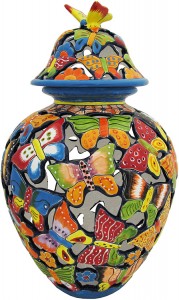There were a number of potters in sixteenth-century Puebla who were originally from the Spanish city of Talavera de la Reina: Gaspar de Encinas and son, as well as their in-law, Diego Gaytan. Though the birthplace of certain potters has yet to be determined, in some cases their last names correspond to families of potters in Puebla.
In the seventeenth century eight Spanish potters were identified (four of whom were originally from Seville, two from Cadiz, one from Barcelona and the other from Galicia), as well as a potter from Portugal and two from Italy. Some emigrated at an early age, completing their apprenticeship in Puebla with established potters, as was the case of Damian Hernandez who studied under Alejandro Pessaro in 1601; and Miguel Perez who studied under Sebastian de Villardel in 1609, both of whom later became important potters in their own right.
Others arrived in Puebla already trained in their craft and consequently influenced the shape and design of ceramics in Puebla, including potters such as the elder Gaspar de Encinas, Alejandro Pessaro. Juan Rodriguez de Herrera, Juan Bautista SalomOn, Antonio de Vega, Diego Gaytan, Jose Escoto, Sebastian de Villardel and Diego Salvador Carreto. No Spanish potters have been identified since the eighteenth century. Those identified were originally from Puebla though they considered themselves Spanish, that is, chaos. There were also potters who identified themselves as “dark-skinned” or mestizo. Its important to emphasize the Ordinances which, in fact, determined that only Spaniards could take the examination which would afford them the title of master potter, even though workshop artisans and servants were mostly indians, mulattos and blacks. By the late eighteenth century, mestizos and mulattos were eventually allowed to qualify for this examination.
On August 5, 1652, “light and dark skinned” potters from Puebla gathered and authorized Diego Salvador Carreto to ask that the viceroy establish examinations and publish Ordinances “determining the conditions, grievances, obligations and circumstances required for the benefit of the craft.” Viceroy Luis Enriquez de Guzman, Count of Alva de Liste, answered the petition and issued an order addressed to the mayor of Puebla asking him to arrange a meeting so that potters could elect an inspector and two deputies to write the Ordinances.
Article excerpt from Artes de Mexico Magazine – June 1992

